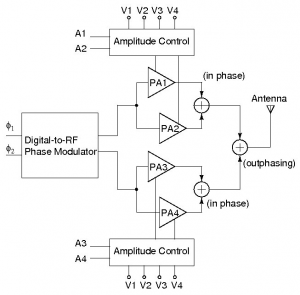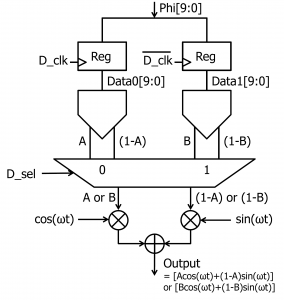Asymmetric Multilevel Outphasing for mm-Wave Transmitters
- Category: Circuits & Systems
- Tags: Joel Dawson, Zhen Li
With the continued communication systems trend towards high data rates come increasingly high signal bandwidths. If the carrier frequency is not increased along with the bandwidth, then the resulting system requires an ultra wideband transmitter. With a carrier frequency at mm-wave frequencies, however, a signal bandwidth of, for example, 2 GHz becomes a relatively small fractional bandwidth.
Our objective is to develop a transmitter that not only is linear and efficient but also operates at high powers at mm-wave frequencies. By building on the Asymmetric Multilevel Outphasing (AMO) architecture presented in [1] , we intend to employ mm-wave and architectural techniques to achieve a data rate of 2 GSymbols/second. With our particular focus on high bandwidth and high average efficiency, combined with the difficulty of designing efficient mm-wave power amplifiers (PAs), we have modified the AMO architecture to improve its data rate and theoretical average efficiency.
AMO works as a hybrid of polar and outphasing transmitters. The signal to be transmitted is decomposed into two outphased signals, as in the LINC architecture [2] [3] , but with discretely and independently varying amplitudes. Figure 1 shows a block diagram of the architecture. At high carrier frequencies it becomes necessary to use multiple parallel PA cells with their outputs combined. As shown, the cells are grouped in an advantageous way: into four PA blocks with independently driven amplitude. The additional amplitude paths on average result in reduced loss from outphasing as compared to the 2-way AMO system in [3] . A time-interleaved digital-to-RF phase modulator is employed for the high-bandwidth requirement. Weighted quadrature signals at the carrier frequency are combined to produce an output with an arbitrary phase shift as in [4] . As shown in Figure 2, with 2-way time-interleaving, the phase modulator can operate at twice the speed of the current-steering DACs, and the resulting data rate is doubled.
- Figure 1: AMO architecture adapted for mm-wave transmitter.
- Figure 2: Simplified top-level block diagram of a time-interleaved mm-wave phase modulator.
- S. Chung, P. A. Godoy, T. W. Barton, Z. Li, T. W. Huang, D. J. Perreault, and J. L. Dawson, “Asymmetric multilevel outphasing architecture for multi-standard transmitters,” in Proc. IEEE Symposium on Radio Frequency Integrated Circuits, pp. 237-240, Jun. 2009, Boston, MA. [↩]
- D. Cox, “Linear amplification with nonlinear components,” IEEE Transactions on Communications, vol. 12, pp. 1942-1945, Dec. 1974. [↩]
- Y.-J. Chen, K.-Y. Jheng, A.-Y. Wu, H.-W. Tsao, and B. Tzeng, “Multilevel LINC system design for wireless transmitters,” in Proc. International Symposium on VLSI Design, Automation, and Test, pp. 25-27, Apr. 2007. [↩] [↩]
- M. E. Heidari, M. Lee, and A. A. Abidi, “All digital outphasing modulator for a software-defined transmitter,” IEEE Journal of Solid State Circuits, vol. 44, pp. 1260-1271, Apr. 2009. [↩]

